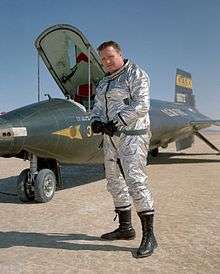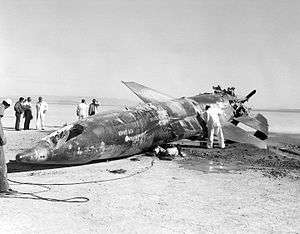John B. McKay
| John B. McKay | |
|---|---|
 | |
| USAF / NASA Astronaut | |
| Nationality | American |
| Status | Deceased |
| Born |
December 8, 1922 Portsmouth, Virginia, U.S. |
| Died |
April 27, 1975 (aged 52) Lancaster, California, U.S. |
Other names | John Barron McKay |
Other occupation | Naval aviator, test pilot |
| Virginia Tech, B.S. 1950 | |
| Selection | 1957 MISS Group |
| Missions | X-15 Flight 150 |
John Barron McKay (December 8, 1922 – April 27, 1975) was an American naval officer and aviator in World War II, test pilot, and one of the first pilots assigned to the X-15 flight research program at NASA's Flight Research Center, Edwards Air Force Base, California. As a civilian research pilot and aeronautical engineer, he made 30 flights in X-15s from October 28, 1960, until September 8, 1966. His peak altitude was 295,600 feet (55.98 miles), and his highest speed was 3,863 mph (Mach 5.64).
Early life and education
Born on December 8, 1922, in Portsmouth, Virginia, to parents Milton Barron McKay (1895–1974) and Wilhelmina Emaline McKay (née Dearing; 1885–1970). During World War II he served as a Naval Aviator in the Pacific Theater, earning the Air Medal with two clusters, and a Presidential Unit Citation. He graduated from Virginia Polytechnic Institute in 1950 with a Bachelor of Science degree in Aeronautical Engineering. He was married and had eight children.
Test pilot
McKay worked for the National Advisory Committee for Aeronautics (NACA) and its successor, NASA, from February 8, 1951 until October 5, 1971, and specialized in high-speed flight research programs. He began as an NACA intern, but assumed pilot status on July 11, 1952. In addition to the X-15, he flew such experimental aircraft as the D-558-1, D-558-2, X-lB, and the X-lE. He has also served as a research pilot on flight programs involving the F-100, F-102, F-104, and the F-107. In 1958, McKay was selected for and would have participated in the U.S. Air Force's Man In Space Soonest program, had it come to fruition.
McKay wrote several technical papers, and was a member of the American Institute of Aeronautics and Astronautics, as well as the Society of Experimental Test Pilots.
Accident

On 9 November 1962, McKay undertook Flight 74 of the X-15 program on the X-15 56-6671 which was the Number-Two X-15 on its 31st flight. The X-15 was attached to its mothership the Boeing NB-52B Stratofortress 53-008, nicknamed Balls 8. McKay's mission was to reach an altitude of 125,000 feet at Mach 5.5 and to fly the aircraft without the lower part of its ventral fin. Further, the mission was to determine the flight response and stability of the aircraft and the characteristics of its flight boundary layer.[1]
The X-15 was released from the Stratofortress on schedule at 45,000 feet over Mud Lake, Nevada at 10:23:07.0 local time with a launch speed of 450 knots. Upon release, McKay was unable to attain the full power of the rocket engine which became stuck at 30% power and unresponsive to throttle control. Due to the lack of throttle response it was decided to make a forced landing at Mud Lake instead of landing at Edwards Air Force Base due to concerns about the reliability of the engine. McKay was at an altitude of 53,950 feet having attained a speed of Mach 1.49 when he started his descent for landing at Mud Lake. The motor was kept operating for 70.5 seconds to burn excess fuel and to reduce weight. The flaps failed to activate during landing and the aircraft speed at touchdown was higher than normal. Due to the excess speed and weight the aircraft experienced failures because of the increased dynamic loading which eventually led to its overturning.[1]
Death
John B. McKay died on April 27, 1975 in Lancaster, California at the age of 52. The injuries he had sustained during his X-15 crash (rolled inverted during rollout with his helmet dug into the lakebed) were major contributing factors.[2] McKay, who also suffered from diabetes, turned to alcohol to numb the pain of his accident injuries. Liver disease was a contributing factor to his death.[3] In 1996, he was inducted into the Aerospace Walk of Honor, and in 2005 he was posthumously awarded Astronaut Wings.[4]
Awards and honors
- Air Medal (two clusters)
- Presidential Unit Citation
- John J. Montgomery Award
- National Society of Aerospace Professionals
- Award for Achievement, National Aeronautics Association
- Virginia Polytechnic Institute’s Hall of Fame
- Aerospace Walk of Honor (1996).
References
- 1 2 "9 November 1962". This Day in Aviation.
- ↑ The X-15 Rocket Plane: Flying the First Wings Into Space by Michelle L. Evans, "When they did the autopsy, it showed quite a bit of brain damage..." (p163)
- ↑ The X-15 Rocket Plane: Flying the First Wings Into Space by Michelle L. Evans, "When they did the autopsy, it showed quite a bit of brain damage..." (p163)
- ↑ Johnsen, Frederick A. (2005-08-23). "X-15 Pioneers Honored as Astronauts" (Press release). NASA. Retrieved 2008-03-12.
Bibliography
- Thompson, Milton O. (1992) At The Edge Of Space: The X-15 Flight Program, Smithsonian Institution Press, Washington and London. ISBN 1-56098-107-5
External links
- Astronautix biography of John B. McKay
- Spacefacts biography of John B. McKay
- McKay page at Astronaut Memorial
- John B. McKay at Find a Grave